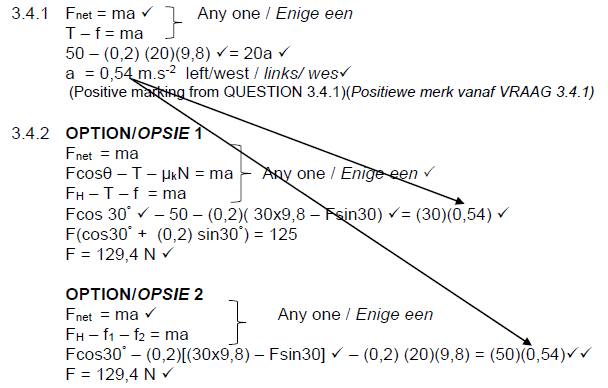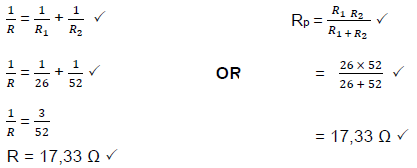Technical Sciences Paper 1 Grade 12 Memorandum - NSC Past Papers And Memos September 2020 Preparatory Examinations
Share via Whatsapp Join our WhatsApp Group Join our Telegram GroupMEMORANDUM
QUESTION 1
1.1 C (2)
1.2 D (2)
1.3 C (2)
1.4 A (2)
1.5 C (2)
1.6 A (2)
1.7 D (2)
1.8 D (2)
1.9 B (2)
1.10 A (2)
[20]
QUESTION 2
2.1
 (2)
(2)
2.2 An object will continue its state of rest or uniform motion in a straight line unless it is acted upon by a net force. (2)
2.3 Block will continue its state of uniform motion (constant velocity). (2)
[6]
QUESTION 3
3.1 When a net force acts on an object, the object will accelerate in the direction of the force. This acceleration is directly proportional to the net force and inversely proportional to the mass of the object. (2)
3.2 No net external force act on the system. (2)
3.3
 (5)
(5)
3.4 
3.5 3.5.1 Decreases (1)
3.5.2 Decreases (1)
3.6 Fnet decreases, therefore acceleration decreases. (2)
[22]
QUESTION 4
4.1 Momentum is the product of mass of the object and its velocity. (2)
4.2 Momentum (1)
4.3
- ∑pi = ∑pf East = +ve)(Oos = +) Any ONE
m1v1i + m2v2i = m1v1f + m2v2f
(5)(4) + (3)(0) = (5)( - 0,25) + (3)(v2f)
v2f = 7,08 m.s-1 east (4)
4.4
- Law of conservation of momentum
(Negative marking)
Total linear momentum in a closed system remains constant. (3)
[10]
QUESTION 5
5.1 100 000 N due east (2)
5.2 -ve Newton’s Third law of Motion - When object A exerts a force on object B, object B simultaneously exerts an oppositely directed force of equal magnitude on object A. (3)
5.3 It is the product of the resultant/net force acting on an object and the time the resultant/net force acts on the object. (2)
5.4
- OPTION 1
West is taken as positive
Fnet ∆t = ∆p
Fnet(truck) ∆t = ( mvf – mvi)
(- 100000)(0,4) = (5000)[(vf) – 20]
vf = 12 m.s-1 west - OPTION 2
East is taken as positive
Fnet ∆t = ∆p
Fnet(truck) ∆t = ( mvf – mvi)
(100000)(0,4) = (5 000)[(vf) – (-20)]
vf = - 12 m.s-1
vf = 12 m.s-1 west (4)
[11]
QUESTION 6
6.1 6.1.1 Work done is defined as the product of the force applied on an object and the displacement in the direction of the force. (2)
6.1.2 Tension Force of gravity (2)
6.1.3 Fnet = 0
Block of bricks is moving with constant velocity (2)
6.1.4
- P = Fv F = mg = (50)(9,8) = 490 N
P = (490)(5)
P = 2 450 W (4)
6.2
6.2.1 Total mechanical energy of a closed system remains constant. (2)
6.2.2
- ME at a height h above the ground:
MEh = ½mv2 + mgh
MEh = ½(0,5)(10)2 + (0,5)(9,8)h …….. (1)
ME⅔h = ½(0,5)(20,34)2 + (0,5)(9,8)(⅔h ) …… (2)
(1) = (2)
½(0,5)(10)2 + (0,5)(9,8)h = ½(0,5)(20,34)2 + (0,5)(9,8)(⅔h )
(⅓h)(9,8)(0,5) = 78,43
h = 48,02 m
ME = ½(0,5)(10)2 + (0,5)(9,8)(48,02)
ME = 260,3 J (6)
6.2.3
- (ME)at h = (ME)ground ?
260,3 = mgh + ½mv2
260,3 = 0 + ½(0,5)(v2) ?
v = 32,27 m.s-1 ? (3)
6.3
6.3.1 0 J ? Normal force is perpendicular to the direction of the displacement. (3)
6.3.2
- W = F∆xcosθ ?
W = (10)(4)(cos0°) ?
W = 40 J ? (3)
[27]
QUESTION 7
7.1 A body which regains its original shape and size completely when the deforming force is removed. (2)
7.2 The internal restoring force per unit area is called stress. (2)
7.3 7.3.1 Stress is directly proportional to strain. (2)
7.3.2 Hooke’s law (1)
7.3.3 Tungsten
Graph of tungsten is steeper than steel. (2)
7.3.4
- m = 5,4 ×109−0
3×10−2−0
m = 1,8 × 1011
Modulus of elasticity = 1,8 × 1011 Pa (3)
7.4
7.4.1 The property of the fluid to oppose relative motion between the two adjacent layers. (2)
7.4.2 Water
The lower the viscosity, the faster the flow. (2)
7.4.3 As the temperature of the fluid increases, its viscosity decreases. (2)
7.5
7.5.1 Pascal's law states that in a continuous liquid at equilibrium, the pressure applied at a point is transmitted equally to the other parts of the liquid. (2)
7.5.2
- F1 = F2 ?
A1 A2
1765 ?= F2 ?
284×10−6 507×10−6
F2 = 3 150,9 N (4)
7.5.3 Increases (1)
7.5.4 Bulldozer’s working systems, dentists’ chairs, hydraulic lifts used to lift heavy loads, car jacks (ANY TWO) (2)
[27]
QUESTION 8
8.1
8.1.1 The process of adding impurities to intrinsic / inpure semiconductors. (2)
8.1.2 5 (1)
8.1.3 n-type (2)
8.1.4 In n-type material current is due to electrons whereas in p-type the current is due to holes. (2)
8.2
8.2.1
- C = ?0?
?
C = 8,85 ×10−12×10×10−4
1×10-2
C = 8,85 × 10-13 F
Q = CV
Q= (8,85 × 10-13)(12)
Q = 1,06 × 10-11 C (6)
8.2.2 Zero (1)
8.2.3
- Area of the plate
- Distance between the plate
- Dielectric used ( Any TWO) (2)
8.3
8.3.1 Energy transferred per second. (2)
8.3.2
 (3)
(3)
8.3.3 (3)
(3)
8.3.4  (3)
(3)
[27]
TOTAL: 150